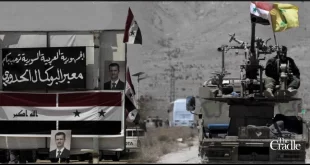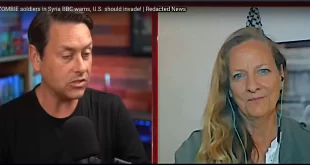by Jared Szuba, published on Al-Monitor, August 24, 2022
Notice the language: They refer to “Iran Linked” militias. So, Are these Iranians? Probably not. [Editor]
The US military said it carried out precision airstrikes against a bunker complex used by Iran-backed militias in eastern Syria early on Wednesday.
US President Joe Biden authorized the strikes on Tuesday in response to recent targeting of two US bases in Syria with rockets and armed drones. US military officials said groups tied to Iran’s Islamic Revolutionary Guard Corps were behind those attacks, but have not specified which.
Eight US fighter jets, four F-16s and four F-15s, dropped guided bombs on nine bunkers at the Ayyash depot in Syria’s Deir ez-Zor province around 4 a.m. local time on Wednesday, US officials said.
The site is used by IRGC personnel and affiliated militias for logistical purposes and to store munitions, White House National Security Council spokesperson John Kirby confirmed publicly today. American forces had closely surveilled the facility for more than four hundred total hours leading up to the strikes, according to military officials briefed on the operation.
US officials deliberately excluded two of the 13 bunkers at the site when compiling the target list, citing uncertainty as to whether bombing them could harm civilians. Less than an hour before the operation kicked off, commanders rescinded plans to strike two other bunkers due to the presence of seven unidentified individuals nearby, according to one military official who spoke on the condition of anonymity.
“We have confirmed there are no casualties,” the official said, adding that the seven people observed at the site prior to the strikes were still visible on aerial surveillance footage following the operation.
Deir Ezzor 24, an online network citing on-the-ground sources in eastern Syria, reported earlier today that 10 pro-Syrian regime fighters were killed in the strikes, including at least two from the Iran-backed Fatimeyoun Brigades. US defense officials declined to specify which militias were associated with the Ayyash complex.
Why it matters: The retaliatory strikes came just over a week after two separate US-led coalition bases in eastern Syria were subjected to what appeared to be coordinated rockets and drones attacks.
Last Monday, at least two armed drones targeted al-Tanf garrison, a remote US Special Operations outpost on Syria’s southern border with Iraq and Jordan. That same day, rockets landed near the Green Village base on the east side of the Euphrates River in rural Deir ez-Zor. Additional unfired rockets were later found nearby, the coalition said. No one was reported hurt in either incident, but similar attacks in the past have killed US and allied personnel.
The coalition revealed earlier today that the drone attack on Al-Tanf was launched from Iraqi territory. Drone components recovered from the wreckage originated from Iran, the Pentagon’s top policy chief Colin Kahl told reporters today.
“We believe that we have Iran dead to rights on attribution. The UAV [drone] parts that we’ve collected, for example, trace directly to Tehran,” Kahl told reporters.
“Our concern was that this might be an indication that Iran tends to do more of this, and we wanted to disabuse them of any sense that that was a good idea,” he said.
The US airstrikes also came as the Biden administration submitted its response to Iran’s markup of the European Union’s “final” draft agreement for a mutual return to the 2015 nuclear agreement, known as the Joint Comprehensive Plan of Action (JCPOA). Iranian leaders have refused to negotiate about the country’s conventional weapons development and support for militias in the region as part of the talks.
“Whether the JCPOA is reborn or not, it actually has nothing to do with our willingness and resolve to defend ourselves,” Kahl explained today.
“I think the strike last night was a pretty clear communication to the Iranians that these things are on different tracks,” he said.
President Joe Biden authorized the military’s response under Article II of the US Constitution in order to “defend US personnel by disrupting or deterring attacks by Iran-backed groups,” US Central Command said in a statement following the operation.
“Today’s strikes were necessary to protect and defend US personnel. The United States took proportionate, deliberate action to limit the risk of escalation and minimize risk of casualties,” CENTCOM’s chief spokesperson US Army Col. Joe Buccino said.
Quiet conflict. This isn’t the first time the United States has bombed facilities used by IRGC-backed militias in Syria in a bid to halt the cycle of attacks, and if the past is any guide, it may not be the last.
The latest US response was designed to deter attacks by Iran-backed groups as a whole. The US military believes the IRGC-backed group that controls the Ayyash facility was not involved in the recent attacks on Green Village and al-Tanf, Al-Monitor has learned.
Last June, US aircraft bombed facilities in Iraq and Syria that the Pentagon said had been used by the militias stage attacks on American-led coalition forces. Biden had previously authorized strikes on buildings used by Iran-backed groups at the Qaim crossing near the town of Albukamal, on Syria’s border with Iraq, in February 2021.
The crossing lies along the main overland route used by Iran-backed militias to transit weapons, supplies and personnel from Iraq into Syria. The US military presence at al-Tanf, roughly 150 miles to the southwest, obstructs their access to the coveted Baghdad-Damascus highway.
The American base at al-Tanf has come under drone attack at least three times over the past year. In December, a British fighter jet shot down a drone approaching the base. A barrage of as many as five drones forced US troops to temporarily evacuate parts of the garrison last October. That attack damaged living quarters and a recreational facility, but no injuries were reported.
The United States has provided some intelligence and military support for Israel’s quiet campaign of airstrikes in Syria, in an attempt to help stem the flow of arms to Iran-backed groups in Lebanon and the Levant.
Last week’s drone attack on al-Tanf came just hours after suspected Israeli aircraft reportedly struck Iran-linked targets near Damascus and Tartous, on Syria’s Mediterranean coast. Syrian regime media claimed three of its soldiers were killed in the strikes.
Iranian state media reported yesterday that an IRGC general “was martyred” on Monday during an advising mission in Syria, but offered no clarity on the circumstances of his death.
Some 900 US troops remain in Syria in the wake of the multinational war against the Islamic State (IS). They and the local militias that they support are not authorized to attack forces other than IS and al-Qaeda, unless acting in self-defense.
Attacks by suspected Iran-linked groups on coalition sites in Iraq and Syria have been less frequent in recent months following a spate of incidents in January, which marked the second anniversary of the US targeted killing of IRGC Quds Force commander Qasem Soleimani in Baghdad.
Jared Szuba is Al-Monitor’s Pentagon correspondent. He previously reported for The Defense Post from Washington, Iraq, Syria and Egypt, and edited at Ahram Online in Cairo. On Twitter: @JM_Szuba. Email: jszuba@al-monitor.com.
 Syria Support Movement solidarity with the Syrian people
Syria Support Movement solidarity with the Syrian people





